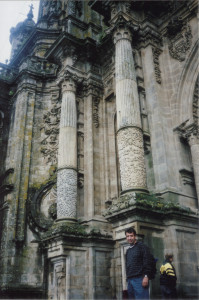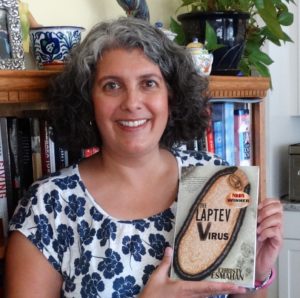As I mentioned in my last post, my son was born on July 24th. It was late afternoon when I finally “gave to light” as they say in Spanish, which is really quite a beautiful, metaphorical way to put it, but because of how late it was, and how tired I was, the first real meal I had in the hospital was on the morning of July 25th—and what a meal it was! It was a meal fit for a king: several types of sweet breads, thick Spanish hot chocolate, fruit, cheese, ham…it was more like a feast than anything I would have imagined eating in a hospital. When I saw the bounteous tray laid before me, I looked over at the friendly woman in the other bed in my room, who had given birth to preemies a few weeks earlier and was recovering from her C-section, and she said, “Now don’t get used to it. It’s not like this every day.”
I must have shaken my head in question, even though I had already been living in Spain for five years and should have known what she was talking about. But I was (understandably) still groggy, still overwhelmed and awed by the tiny creature sleeping in a little drawer by my bedside, and she was kind and patient and knew that I was a foreigner, so she elaborated, “It’s Spain’s birthday! It’s Santiago, the patron saint of Spain.”And then it clicked! July 25th is one of the largest holidays of the year, outside of Christmas and Easter. It’s a day of festivities, with lots of dancing and parades. Of all days to be in a hospital, when the rest of the country was celebrating!
A very long time ago, some time in the ninth century CE, the remains of Santiago, (St. James, in English,) are said to have been brought from France, following the starry path of the Milky Way, which is also known as the Camino de Santiago or Way of St. James, to be buried in the city of Santiago de Compostela. This city is now the capital of the province of Galicia, in the northwestern corner of the country, just above Portugal, and the gorgeous old part downtown is actually a UNESCO world heritage site.
I first went to this mystical city in 1987 and can still clearly remember its impressive cathedral, with its steps, nearly 1000 years old, worn in grooves where pilgrims had flocked over them, often on their hands and knees, paying homage. Inside the cavernous walls of this holy place, a myriad of statues and carvings, many of them seemingly not very religious and certainly quirky and remarkable, grace the walls and impossibly tall columns. The rest of the city was also fascinating and humbling to roam: so much history, so much stone, so much passion, devotion and love.
All year long, but especially in the summer, people of all ages, ranging from devout to aficionados, and coming from all over the world, make the trek westward across northern Spain, following the Camino de Santiago to end up in Santiago de Compostela. And as you probably can guess by now, July 25th, is especially important here, where there is a HUGE celebration, drawing in thousands of people.
It was on the eve of this major national holiday, and just outside this enchanting city that is so emblematic, that tragedy struck last week. I’ve refrained from looking at the graphic and gruesome images that are circulating after the terrible train crash, preferring instead to cast my mind back to the times I’ve visited and admired Santiago. My deepest sympathy, most heart-felt thoughts and prayers are with the families of the victims of last week’s unfortunate accident.
If you enjoyed this blog post, you might also like my series of novels, Bueno, Sinco and Brujas, which takes place in Santander, Spain.




1 pings
[…] one about Santiago de Compostela, on occasion of the horrible train crash (https://christyesmahan.com/?p=124), one about the fiestas in Pamplona (https://christyesmahan.com/?p=103), and one about a mansion in […]